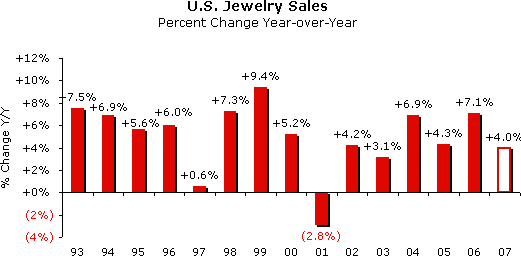IDEX Online Research: U.S. Jewelry Sales Surprisingly Strong in May
July 19, 07
Contrary to earlier forecasts, U.S. specialty jewelers posted solid sales gains in May. Specialty jewelers’ sales rose by a robust 4.7 percent in May versus the same month a year ago. Total jewelry sales were a little softer – +3.5 percent – but were also better than expected. Mother’s Day, which occurs in May, is the third largest sales event of the year for jewelers in America.
May total retail sales (all categories) were also strong, though jewelers lost market share to other retail categories.
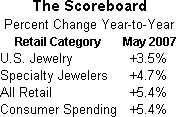 |
The Scoreboard at right summarizes sales gains for the month of May 2007 versus the same period a year ago.
Looking ahead, storm clouds are gathering on the horizon. Preliminary advance retail sales for June indicate that consumers reined in their spending significantly. We believe this may have affected jewelers’ sales, too. Thus, we are expecting weak comparisons when June jewelry sales are reported in August.
Despite the prospects for weak sales in June, we have raised our U.S. jewelry sales forecast for the full year to +4 percent from our prior level of +3.5 percent. While the U.S. economy was weak in the first quarter, there are signs that the economic trough that forecasters had been predicting may not be as deep as expected this year. There is still some uncertainty in the consumer sector, especially related to consumers’ past-due payments and personal bankruptcies. But overall U.S. and global economic vitality seems to be better than expected.
May Jewelry Sales Gains Solid
For the month of May 2007, specialty jewelers posted a solid, though moderate, sales gain of 4.7 percent over the same month a year ago. Total retail sales rose by 5.4 percent versus May 2006. Based on earlier expectations by economic forecasters, both of these gains were above the original predictions for the year.
The graph below illustrates sales trends for both specialty jewelers and all retailers in the U.S. market since the beginning of 2006.
While both the black line on the graph (total retail sales ex-autos) and the red line (jewelry sales) have been sloping downward since early 2006, indicating an overall weakening of consumer demand, it appears that they might be bottoming.
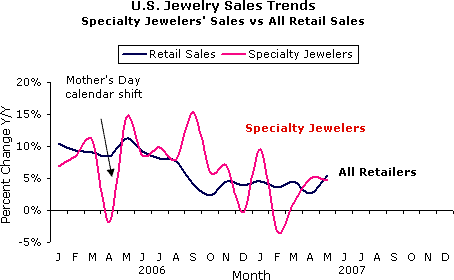
Source: U.S. Dept of Commerce
Among other major retail categories, most merchants posted stronger than expected May sales. Gasoline sales were very strong due to higher prices at the pump. But other categories also showed strong gains, including furniture, home center goods, and automobiles. Interestingly, reports of May sales from individual retailers were more bearish than the aggregate sales comparisons from the U.S. Department of Commerce.
Specialty Jewelers Pick Up Market Share from Other Jewelry Outlets
In a reversal from recent trends, specialty jewelers’ sales gains in May exceeded sales increases posted by other merchants who sell jewelry along with many other retail categories. We believe this may be due to consumers who decided that their local independent jeweler was the retailer of choice for Mothers’ Day jewelry, rather than a general merchant.
The graph below summarizes sales trends for specialty jewelers versus all jewelry since the beginning of 2006.
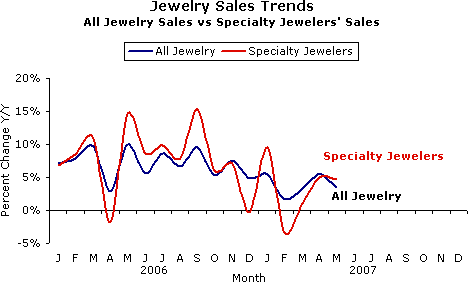
Source: U.S. Dept of Commerce
InStore Magazine Jeweler Poll Confirms Sales Trends
InStore magazine reported that a majority of specialty jewelers posted higher sales in May versus the same month a year ago, based on a sample of 349 retail jewelers in the U.S. market. The graph below summarizes the range of responses from specialty jewelers.
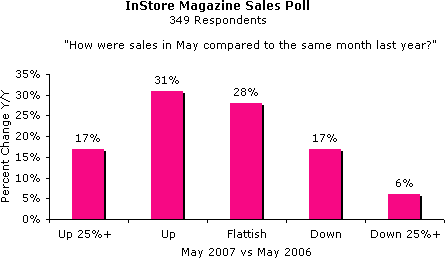
Source: InStore Magazine
Consumer Spending Slows Modestly in May
Perhaps as a precursor to the preliminary June retail sales numbers, overall consumer spending began to slow in May. Economists speculate that several factors could be causing this slowdown, including higher interest rates, slower wage gains, and a change in consumer sentiment.
The graph below summarizes consumer spending trends – all goods and services (green line) – as compared to total retail sales (black line) and jewelry sales (red line).
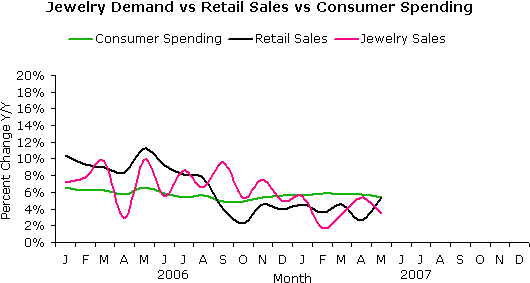
Source: U.S. Dept of Commerce
Forecast: Cloudy Near Term, But Improving Later This Year
The strong sales growth in May was probably an anomaly. The burden on consumers’ wallets remain heavy: gasoline prices are very high and will constrain spending, especially among lower income households. Weakness in the housing market will take an increasing toll on consumer spending growth. While the stock market continues to rise, boosting consumers’ personal wealth, the largest asset on their balance sheets – their home – is not appreciating. In some markets, home prices are depreciating. This pall of gloom will affect consumers’ moods and their willingness to take on new debt. Further, there are some signs that job growth and income gains may be slowing. Finally, the savings rate remains negative and debt burdens are high; these trends must end, perhaps sooner rather than later.
Despite this seemingly negative near term outlook, we have raised our forecast for jewelry sales in the U.S. market for 2007. Forecasters are suggesting that the U.S. economic slowdown will not be either as long or as deep as originally anticipated earlier this year. While economic growth in the first quarter was an anemic +0.7 percent, most forecasters are calling for growth of at least 3 percent for the second quarter ended June. Overall economic growth for the year should be above 2 percent.
As a result of revised economic expectations, we have raised our forecast for jewelry sales in the U.S. market in 2007 to +4.0 percent from our prior prediction of +3.5 percent.
The graph below summarizes actual and estimated jewelry sales trends for the U.S. market by year.
|
|
